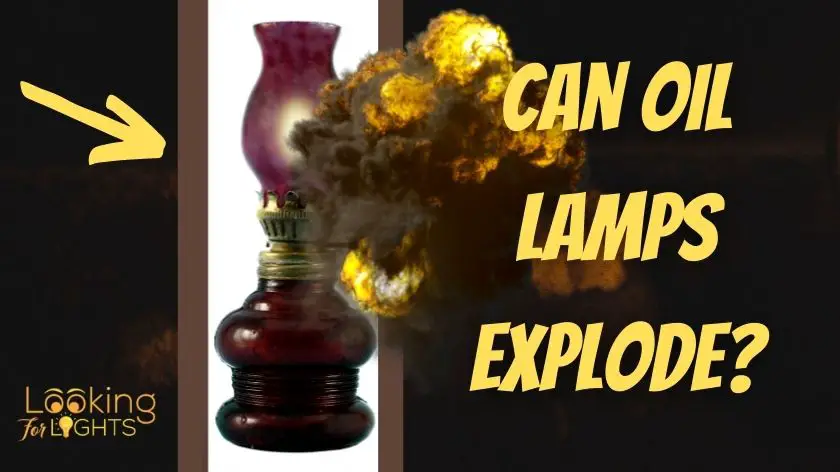Okay, so you have oil lamps in your home or maybe you are thinking of getting one because of their utility. But you might be concerned about their safety and whether they can explode. After all, who would like to get their house burned because of an oil lamp exploding! So let’s see, can oil lamps explode?
Oil lamps can explode when the level of kerosene in the tank decreases after burning and the air space is developed which can then get ignited. Other reasons can be improper usage of the oil lamp and using bad quality kerosene that has flammable gasoline mixed in it.
Read on to know more about why oil lamps explode and how to use them safely to avoid any accidents.

Table of Contents
Why Do Oil Lamps Explode?
#1. Quality Of The Kerosene:
If the kerosene is not quality controlled and of poor quality, and also contains amounts of gasoline then it can be one of the reasons why kerosene lamps could explode. Although, if you buy high-quality kerosene to use as fuel for your oil lamp then in most cases you don’t need to worry much.
Another thing that can be a culprit is maybe the water droplets are present in kerosene. There can be high water content when an emulsion is formed by a kerosene/water mixture. In this condition, tiny water droplets that are surrounded by kerosene are suspended in the kerosene.
You might be thinking why the high water content is dangerous? The answer is that high water content will result in sputtering and flaring. For this reason, some people add salt to cover the bottom of their lamps.
Salt being hydrophilic in nature removes water from the kerosene.
#2. Inappropriate Usage
Let’s say that it is freezing outside and you are about to fill the oil lamp that is still warm because of the recent use. But the kerosene is kept outside at the cold temperature.
Let’s suppose that overfilling the lamp and inserting the wick housing causes a small spill, then in such a case thermal expansion of kerosene can cause more leakage.
Another case you can just imagine is if you carelessly knocked away from your oil lamp while it was still lit. Then in such types of situations, the chance of accidents will be high, right?
And not just you, maybe you have pets in your home who just keep running in your home. So in all such situations, the chances of accidents will increase.
#3. Lamp Design
The flashpoint of kerosene is 100 °F or higher. (Flashpoint is the lowest temperature at which a liquid will form vapor in the air near its surface and flash or briefly ignite when it gets exposed to an open flame).
Now, as kerosene in an oil lamp burns, its level in the tank keeps on decreasing. The air space present above the kerosene is generally pure vapor without any oxygen that can lead it to burn.
But if your lamp design is such that it allows a lot of air to pass into the tank, then it may be likely that the appropriate ratio of fuel vapor to oxygen will be reached. Now, if the wick-holder has a high temperature then that can cause the vapor to ignite.
In oil lamps, the wick-tube is usually made larger than the wick that has to pass through it. It is designed such that the wick can fit tightly in the burner and at the same time the wick can move up and down in the burner without any problem.
So in this type of situation, you may think that it is unavoidable that the space in the tube will be left along the sides of the wick sufficient enough to allow the flame from the burner to pass down and explode the gas.
But the thing is, many things can occur that can cause the flame to pass down the wick like for example, the lamp is on a table and a slight puff of air comes from the open window.
Another reason that can give rise to the condition of explosion and mishappening is using an oil lamp with the chimney broken off at the top. Or sometimes issues can also occur when you use a small size wick for a larger burner thus leaving a substantial space along the edges of the wick.
So it is always recommended to use appropriate oil lamps and high-quality oil as fuel. By the way, if you experience that your oil lamp wick burns out faster, then don’t forget to check out my guide on why oil lamp wick burns faster.
Are Oil Lamps Flammable?
Well, kerosene is usually used as a fuel in oil lamps, and kerosene is a flammable hydrocarbon liquid. So yes, there will always remain a chance of mishappening while dealing with oil lamps and so taking proper care is very important while using the oil lamp.
You should always try to fill kerosene outside your house. And if some kerosene spills, make sure to clean it immediately. Never leave your kerosene lamp unattended and handle the oil lamp and kerosene with the required care.
How To Safely Use An Oil Lamp? (Tips!)
- The first and foremost thing to keep in mind is oil lamps can easily knock over, so make sure to keep them on leveled surfaces.
- Also, adjust the wick of the oil lamp until it is barely visible so that the flame stays low inside the chimney.
- Try to never leave your oil lamp unattended. If you are about to leave your house or go to sleep then it is recommended that you turn off the oil lamp to avoid any unnecessary happenings such as accidental falls or any other problematic situations.
- Moreover, you should also not store the tank with oil in it. And try to keep the oil lamp out of the reach of the children and pets.
- Always make sure to use only reliable fuel and avoid using ignitable fuels such as gasoline.
Conclusion
As a general rule, as long as you use high-quality oil for your oil lamp and use the oil lamp appropriately with proper care, you won’t need to worry much. But since you will be handling flammable items, make sure to take all the precautionary measures. That’s it! Thanks!

